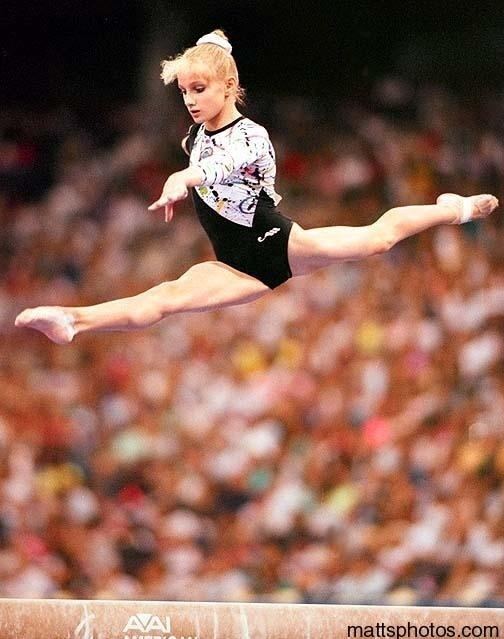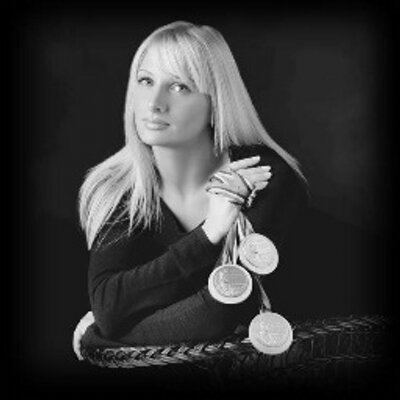Olympic Games 2 Role Olympic athlete World Championships 1 | European Championships 3 Disciplines Artistic gymnastics Name Tatiana Gutsu | |
 | ||
Full name Tatiana Konstantinivna Gutsu Similar People | ||
Live in the D: Olympic gold medalist Tatiana Gutsu
Tatiana Gutsu (Ukrainian: Тетяна Костянтинівна Ґуцу, Romanian: Тatiana Guţu; born September 5, 1976, in Odessa, Ukrainian SSR) is a former artistic gymnast from the Soviet Union and the winner of the all-around title at the 1992 Summer Olympics. Renowned as a trickster, she performed some of the most difficult routines in the sport.
Contents
- Live in the D Olympic gold medalist Tatiana Gutsu
- Tatiana Gutsu 1992 Olympics AA Floor
- Career
- 1992 Olympics
- Competitive history
- References
Tatiana Gutsu 1992 Olympics AA Floor
Career

Born into a Ukrainian family with Romanian roots, Gutsu started in gymnastics at age 6. She became a member of the national team of the Soviet Union in 1988. Her first major international competition was the 1991 World Artistic Gymnastics Championships in Indianapolis, where she won the team title with the Soviet Union and finished fifth in the individual all-around, while winning silver medals in two individual apparatus finals: the uneven bars and balance beam. Her silver on beam was highly controversial because the winner, Soviet teammate Svetlana Boginskaya, performed a simpler routine.

Gutsu was quickly noticed for the difficulty of her routines. She was one of the first gymnasts in the world to perform a double-twisting Yurchenko vault. She also debuted a double layout somersault on floor with split legs in the first salto, a skill that few others have been able to perform. Perhaps most impressively, she ended her floor routine in the team competition with a double layout somersault.

The following year, she had a disastrous showing at the 1992 World Championships. She had been expected to contend for gold on three events—uneven bars, balance beam, and floor exercise—but failed to reach the finals on any of them, suffering falls on both the bars and floor. However, at the European Gymnastics Championships that year, she won the all-around, vault, and uneven bars titles, as well as a silver on the balance beam. She was the most successful gymnast of the championship and established herself as one of the favorites for the Olympic all-around title.
1992 Olympics

In the preliminary round of competition at the Olympics, Gutsu, then 15, fell from the balance beam and was ranked 9th in the all-around. She had been on course to win the optional portion of the team competition and was one of the favourites for the beam gold medal, but the fall meant she did not qualify for the beam final.
Although 36 gymnasts qualified for the all-around, only three competitors from each country were allowed in the final, and because of Gutsu's fall, three other competitors from the Unified Team placed higher in the preliminaries. However, the team coaches felt that Gutsu had a better chance of bringing home all-around gold than her teammates Boginskaya and Rozalia Galiyeva. They considered scratching Boginskaya, but felt that she was too famous and there would be a scandal. As a result, they forced Gutsu's younger teammate Galiyeva to forfeit her place in the final so that Gutsu could compete. Galiyeva was forced to claim a severe knee injury, which was "verified" by the team physician.
In one of the deepest fields ever for the all-around, Gutsu was in a close race for the gold medal. She had a few balance checks in her difficult beam routine and made an error on her double layout on floor, allowing her rivals to stay in contention with her. With one apparatus to go, Gutsu was tied for first place with Shannon Miller of the United States. Her final performance on vault (a full-twisting layout Yurchenko) was just enough to hold off Miller's challenge. Gutsu won the title by .012, which remains the closest margin of victory ever in an Olympic all-around. She also took home medals in the team competition (gold), uneven bars (silver) and floor exercise (bronze).
What set Gutsu apart from Miller was her difficulty. She was competing during the height of the "pixie" era, when the favoured type of gymnast was a small athlete capable of extreme difficulty, and Gutsu exemplified this. She performed the same vault as most other leading gymnasts (except Tatiana Lysenko), but her difficulty on the other three events was high. Her beam routine was especially notable: She competed probably the most difficult dismount sequence of all time, three back handsprings into a tucked full-in, and also performed a standing back somersault with a full twist. On floor, Gutsu opened with a split-leg double layout and closed with a piked full-in. On bars, she dismounted with a double layout. Miller showed less difficulty, particularly on the floor exercise (where she performed a whip to tucked full-in for her mount, a whip to double pike for her middle pass, and a tucked full-in for her dismount), but was impressive on beam with her back handspring to three layouts sequence, her superior form, and a stuck full-in dismount.
Galiyeva was always angry and bitter about having given up her place in the all-around to Gutsu, feeling that she had had no option but to agree. The two split the prize money between them, but they stopped speaking after the Olympics. The substitution was against the rules (as Galiyeva's injury was not genuine), but such switches were and are common in gymnastics, usually when a gymnast considered to be the best on the team makes a mistake in qualifications and thus finishes behind a teammate who is considered weaker. Other notable examples include the replacement of Alexandra Marinescu with Simona Amânar in the 1996 Olympics, and the Soviet coaches' removal of Olga Mostepanova and Irina Baraksanova for Elena Shushunova and Oksana Omelianchik in the 1985 World Championships. On both occasions, the gymnasts substituted in took a medal. Coaches now have the right to make such substitutions without having to falsify injuries.
After retiring from competitive gymnastics, Gutsu moved to the United States, where she is a gymnastics coach in Michigan. She tried for a comeback to compete at the 2003 World Artistic Gymnastics Championships as a three-event specialist (vault, beam, and floor), but was unsuccessful.
